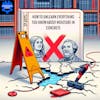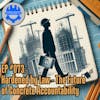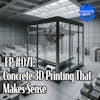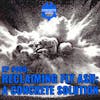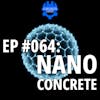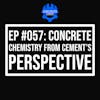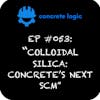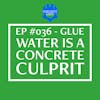EP #070: Concrete vs. Microbes: The Battle Beneath Our Streets
In this episode of the Concrete Logic Podcast, host Seth talks to Sam Lines from ConSeal about microbial-induced concrete corrosion, particularly in the sewer system. They discuss various ways to mitigate this, including using antimicrobials and the potential consequences for failing to do so.
Sam highlights the importance of designing sewer systems well, considering factors such as expected mass loss and humidity levels. He also talks about current research and potential future technologies that could help protect concrete from this type of corrosion.
Takeaways
1. Understand the concept and negative impacts of microbial-induced corrosion on concrete used in sewer systems.
2. Learn about mitigation strategies such as antimicrobials and plastic liners to reduce concrete corrosion.
3. Get introduced to ongoing research and projects to create mitigation methods for microbial-induced corrosion.
4. Discover the importance of factors including oxygen levels, sulfur presence, and relative humidity in the corrosion process.
5. Explore the potential of enhancing concrete's resistance to corrosion through quality improvements and the use of substances like antimicrobials.
Chapters
00:01 Introduction and Podcast Mechanics
02:11 Understanding Microbial Induced Corrosion
04:37 The Role of Bacteria in Corrosion
09:54 The Impact of Corrosion on Concrete
14:54 Designing for Corrosion Resistance
22:49 The Role of Antimicrobials in Corrosion Resistance
31:40 The Impact of Humidity on Corrosion
37:51 Closing Remarks and Contact Information
***
Did you learn something from this episode? If so, please consider donating to the show to help us continue to provide high-quality content for the concrete industry.
Donate here: https://www.concretelogicpodcast.com/support/
***
Episode References
Guest: Sam Lines | ConSeal | slines@conseal.com Guest Website: https://conseal.com/
Producers: Jodi Tandett, Jace Stocker
Donate & Become a Producer: https://www.concretelogicpodcast.com/support/
Music: Mike Dunton | https://www.mikeduntonmusic.com | mikeduntonmusic@gmail.com | Instagram @Mike_Dunton
Host: Seth Tandett, seth@concretelogicpodcast.com
Host LinkedIn: https://www.linkedin.com/in/seth-tandett/
Website: https://www.concretelogicpodcast.com/
LinkedIn: https://www.linkedin.com/company/concrete-logic-podcast
[00:00:00] Seth: And welcome to another episode of the Concrete Logic podcast today. I have a new guest, Sam Lines with ConSeal. He's gonna share his expertise on microbial-induced corrosion. I was practicing how to say that Sam, before we got started, that's a mouthful. So before we get started in that like, like I've been doing in the last handful of episodes, just to remind you folks how this works.
[00:00:27] So if you are listening to this episode and Sam teaches you something today and you want to show that you got value out of this podcast, what we ask you to do is there, you got a few options. One is. Again, if you learn something from this, share this with somebody, share it with somebody in the concrete industry, because I know I'm going to learn something today.
[00:00:49] This is the first time I've discussed this topic. So, the 2nd option for you is if you go to the, to the website ConcreteLogicPodcast.com. There is a link in the bottom right-hand corner. It looks like a microphone. You click on that microphone. You can record a message and shoot me a voicemail and you can either say, hey, it's a great podcast, or you could say, Hey, that's a terrible podcast, or you could give me an idea for a guest.
[00:01:19] Or a topic, which would be greatly appreciated. A lot of them, including Sam here, a lot of our guests and our topics are from listeners. There it's a suggestions from listeners or past guests as well. So, that's very helpful. And then the last option is if you go back to the website in the upper right-hand corner on the homepage, there is a donate button.
[00:01:41] If you hit that donate button, it'll allow you to donate any amount. To the show. So if you wanna donate a dollar, $5, $10, $50, I had a $50 donor the other day, which was awesome. If you want to do that'd be greatly appreciated. Any amount helps. Helps this thing keep going and if you've been listening for a while and you're feeling a little guilty you've been listening to the podcast for a while, just get out of the way before the end of the year.
[00:02:06] so, since we got through that, Sam let's get into the topic at hand. So we're going to talk about microbially induced corrosion of concrete. Yes, what the heck? Yeah, what the heck is that?
[00:02:22] Sam Lines: Yeah. All right. Well, first of all It's not a new topic. It's a studied topic that goes back to the 40s.
[00:02:31] There was a professor by the name of Dr. C. D. Parker who first found out that Concrete that deteriorates in a sewer is not deteriorating from the sewer itself. It's deteriorating from a process that's a bacterial process where bacteria Is consuming hydrogen sulfide gas, which then converts that into some acid.
[00:02:58] We'll talk about some of the more technical details later, but he discovered that there were 5 primary bacteria that are involved with this process. Since that time, and since about 700, 000 miles of sewer line exist in the United States, the topic of microbial corrosion has been studied by numerous universities and professors, even around the world.
[00:03:25] This is not just something that happens in the United States. It does happen around the world. And it's also not something that is related to sometimes people will say, well, this didn't happen until 10 years ago and somebody changed the summit type. And now all of a sudden, it's happening. And no, this isn't something that's just started to happen.
[00:03:47] I think. This has been around for a long time, but we're just now really starting to understand what microbial corrosion is. So basically, it's the biogenic conversion of sulfur into sulfuric acid. So that's the really basic way that this Process occurs and what happens in sulfuric acid is very detrimental to concrete.
[00:04:13] Concrete is a very alkaline material and anytime you have something on the high pH scale, and you throw something of a low pH on it, it's like putting Alka Seltzer in your water. It fizzes and then the lime and other calcium materials inside that concrete dissolve and go away. That's the short answer of what microbial induced corrosion is.
[00:04:36] All right.
[00:04:37] Seth: Is the sulfur that you mentioned, is that considered one of the, microbe that's involved with this, or what are the microbes?
[00:04:47] Sam Lines: Yeah, no, that's a good, and I'm not gonna, I'm, I would bash all the names of the microbes that are involved. I know they're part of the thiobacillus strain, but I'll start off with a simple one.
[00:04:57] Analogy, and that is when sewer water or effluent is flowing down a sewer, that sewer water sometimes becomes stagnant. When it becomes stagnant, it becomes oxygen deficient. Once that effluent is oxygen deficient. A bacteria that's a sulfur, sulfate reducing bacteria, that is an anaerobic bacteria, starts to consume sulfur, and in the liquid, in the effluent, it converts that sulfur into hydrogen sulfide gas in the liquid.
[00:05:35] So in the effluent itself, as the sewer sits there, hydrogen sulfide gas is building up. Well that gas is staying in liquid until something else happens, until some instability happens in the system, and It's similar to one of the analogies I like to use is if you take a pop can and you shake it up and give it to somebody, they're going to be a little bit they're going to take a chance and if they open that up, all the carbonation is going to come out and squirt and spill all over them.
[00:06:09] Well, a similar thing when you've got hydrogen sulfide gas in the liquid form. Once there's a little bit of turbulence, maybe a dropped manhole, or maybe some ripples in the water, hydrogen sulfide gas comes out of that liquid and into the airspace. There's some science around this whole process, but the thing is once you've got hydrogen sulfide gas in the airspace, it only takes a very small amount to smell it.
[00:06:37] So you don't have to have hundreds of parts per million to smell it. By the time you get over a hundred parts per million, you can lose your ability to smell hydrogen sulfide gas pretty quickly. So very small amounts, and that's enough to provide the sulfur portion of the hydrogen sulfide gas is then provided as food for the aerobic bacteria that live and grow. There's hundreds and thousands of bacteria around our environment. So these bacteria, we're talking about 5 strings that live above the waterline and they start to consume the sulfur and secrete sulfuric acid. Now we're talking about a surface pH of the concrete at this time of somewhere around maybe 7 to 9 pH on the surface of the concrete, and so the bacteria that live at this area, we call it neutrophilic sulfur oxidizing bacteria.
[00:07:39] Neutrophilic because we're talking about a bacteria that lives in a certain zone, a certain range of surface pH that is not acidic. It's neutral pH. Those bacteria don't secrete a very severe acid. Again, an analogy I use is it's a little bit like a relay race. The first bacteria lives at pH 7, 8, 9.
[00:08:07] And then it lives for a while, but it doesn't like to live at a 6 pH, so it dies off and another strain of neutrophilic bacteria picks up, grabs the baton, and then it runs for a while, and they're consuming this sulfur and excreting a variation of sulfuric acid. Once you get down to a surface pH of about 4, then a bacteria called Thiobacillus thioxidens Or Acidithiobacillus as it's also called.
[00:08:38] That becomes the primary strain of bacteria involved in this process. And that one is very harsh. It secretes the most harsh acid. It's working through the same process, consuming sulfur and then excreting sulfuric acid. Once the concrete pH on the surface is reduced to about 2 to maybe even 1 pH, you start seeing massive amounts of corrosion and mass loss.
[00:09:09] So all that being said, you could have a sewer in place for 10 years, and it may take 8 years before you ever see corrosion of any significance. Because over those years, the pH of the concrete is going from 13, to 12, to 10, to 8, to 7, to 4, to 3, and it gets down to 1, and all of a sudden, the mass loss goes off the charts.
[00:09:39] So that's a I'll stop there and take a breath and let you maybe think of a question to ask from there. But as you can see, I can talk about this and go on for a long period of time. But that's a real short version of how this process happens.
[00:09:54] Seth: once it gets to that point to the, I think you said PH of 2, is it when you start seeing deterioration of the concrete, like the actual physical damage of the concrete?
[00:10:07] Sam Lines: Yeah. Yeah. So, so what happens is you're losing the lime and calcium portions of the concrete. concrete's about 80 percent aggregate, about 20 percent the paste fraction or the glue that glues everything together. Of that 20 percent, about 20 percent of that is pure lime. In a normal ordinary Portland cement concrete, you have calcium hydroxide, Basically lime that sits there in its presence of this paste.
[00:10:39] And that lime is the first thing that gives itself up. It's really easy to lose the lime. It gives itself up in acids. It will it will leach out in rainwater and other things like that. And that's what's bringing the pH of the concrete down. That's its alkaline buffer. But then in the paste portion, the other 15 percent of that paste part of the concrete, you have the calcium silicates, and the calcium silicates also start to give up, but they're slower.
[00:11:08] All this being said if you've got siliceous aggregates, which do not corrode. They cannot be corroded. You could throw them in acid and they don't care. They're not going to corrode in acid. You're going to see the mass of the paste start to deteriorate really quick after the pH of that surface gets down to 2.
[00:11:28] And it will reduce at a point of maybe 2 to as much as 10 millimeters in a year. So a large amount of some of these sewer systems, 10, 12 millimeters in a year, that's nearly a half of an inch of mass loss. Now, if you've got salacious aggregate, you're only gonna lose the paste portion of the concrete.
[00:11:50] If you have calcareous aggregates or limestone aggregates, those aggregates actually also are able to basically give themselves up or neutralize the acid. So what you're going to end up with instead of seeing pitting, In the concrete, when you would see that with siliceous aggregates, with a calcareous aggregate like a limestone, you'll actually see shaving off of the surface uniformly, and you won't necessarily see the mass loss, but if you were going to measure a 48 inch manhole, you might have had 48 inches when it was made, and now you've seen mass loss, it may be 48 and a quarter inch.
[00:12:31] Maybe 48 and a half inch, but it doesn't look like any concrete is gone because it's losing entire mass Not just the paste portion of that concrete Once this happens two to ten millimeters per year. That's on the mild side. I see one to two millimeters per year That's, going to corrode and you're going to lose your manhole or pipe in 20, 25, 30 years in a severe condition where you're talking 10 millimeters per year.
[00:13:03] I've known of some sewer manholes that have lost 7, 8 inches of concrete in their lifetime of about 30, 35 years. And that's a lot of concrete, eight inches of concrete mass loss over time. And it's not necessarily always uniform. Most of the mass loss is right above the flow level of the liquid, the natural flow level.
[00:13:24] 'cause H2o gas is heavier, so that's where the most food is. The other place is right at the top of the crown in a pipe, and that's typically where most of the corrosion exists.
[00:13:38] Seth: Oh, really? Yeah, I was thinking it would be the opposite. It says down below.
[00:13:42] Sam Lines: there's a couple reasons for that and I don't know that there's a scientific process to where it has actually been defined, but some of the reasons when you have the acid formation, calcium sulfate is formed and it creates a little bit of a buffer because now you've got the calcium sulfate that's forming on the surface or basically think of wet drywall and it forms on the surface It starts to act like a protectant.
[00:14:10] Now, this whole process, the sulfur can't get to the bacteria. The aerobic bacteria they're on the concrete surface. They're covered by this material, if you will. And it acts like a protective buffer. But right there at the liquid level, you've got washing, you've got the waves, if you will, of the effluent rising and falling, and it's washing that calcium sulfate off the surface, creating new, fresh paste for the bacteria to attach to.
[00:14:39] And also it creates that, and I'll talk about that in a minute again, but it creates a very moist area and bacteria love to live in a moist. Area as well. And so those are some of the reasons why that's some of the worst areas.
[00:14:54] Seth: do we design for that? Knowing all this happens. I have no experience in the sewers or anything like that, because normally what I know is this is a precast industry, right?
[00:15:09] A lot of it. I have looked at some jobs recently that you do some poor in place systems as well, but majority of it's precast, right?
[00:15:19] Sam Lines: we do design for that. So back in the 70s Dr. Parkhurst and another colleague of his, Dr.
[00:15:25] Pomeroy. Parkhurst and Pomeroy worked for the L. A. Sewer District, L. A. County Sewer District, and I know a few people from, that currently work at the L. A. County Sewer District, and it's been very interesting to talk to them, and they can actually tell me They can go back into some of the old archives from, we're talking 50 years ago, back in the 70s, and this was occurring really significantly in Los Angeles.
[00:15:54] So they, they were studying what had been done and they decided could we anticipate this? Can we look at the sewer environment? Can we look at the flow of the sewer? Can we look at the slope of the sewer? Can we look at how much sulfur is in there? Can we look at all these other factors that, the amount of lime that's available from the concrete?
[00:16:14] Can we look at this and create a predictable model? And they worked on it for a while, and they actually came up with what's called the Parker's Pomeroy model of sulfide corrosion. And this model, actually, you plug in all this information from the sewer line, and what it will do is it will provide you with a mass loss in millimeters per year that's expected.
[00:16:38] So for instance, you've got a mass loss of 5 millimeters per year and you've got a sewer that you want to last 30 years. Let's call it 30 years. So you've got 5 millimeters per year, 30 years, that's 150 millimeters. So you've got to design for 6 inches of concrete cover as sacrificial cover on that sewer for it to last 30 years.
[00:17:05] Ultimately, what we're trying to do is we're trying to protect the steel from corroding and then the structural integrity of the pipeline to collapse. So if this pipe could be done with steel, that's 1 inch embedded in the concrete. They would cast that, that material in, they would cast it in normally, but the cover over that steel would be seven inches instead of six inches.
[00:17:29] So they've got the six inches of sacrificial concrete. So that's one way that people have looked at this and said, okay, we can expect this to happen. And so we're going to plan for it now, we're in a time where concrete used to be. And it still is a very cheap building material, but concrete is also being attacked in the environmental because it's so widely used that the total carbon output of concrete makes it a high emitter of CO2.
[00:18:03] we're trying to look for ways to be efficient with concrete and adding a bunch of concrete on the surface that we expect to corrode is not an efficient way to go about it. So, in the last 20 years, a lot of work has been done to look at other mitigation methods. One mitigation method is to put liners on the concrete, plastic liners.
[00:18:24] Plastic is resistant to acid. And one thing I will say is every mitigation method has a mode of failure. It's just part of what happens in society. Everything has a means by which it could fail. Concrete, plastic, steel you name it. Everything has a mode of failure. And I think it was one of Newton's laws said every system is in a constant state of decay.
[00:18:51] So everything is working on a rate at which it will decay and be lost over time. Plastic was mentioned as one method. Obviously one of the things that the concrete industry including ASTM and the American Concrete Institute. Those organizations are working on how can we make better concrete.
[00:19:13] How can we make concrete that's more resistant to this process? you can put sealers on the concrete. You can put antimicrobials now for the last 20 years or 25 years. Antimicrobial technology is there. So you can make the concrete resistant to the growth of those microbes. So those are some of the things over the last 20, 30 years that have been put into place to protect the concrete.
[00:19:41] Seth: Has anybody looked at you said this stuff can't thrive with oxygen, right? Is they look at pumping oxygen through, there to kill all this stuff or like treat it that way?
[00:19:52] Sam Lines: That's an excellent question, Seth. sewer departments in their sewer systems for years have put hydrogen peroxide or other types of oxygen materials in their effluent.
[00:20:04] And dose that 1 of the problems with that is cost. That's a maintenance issue. So they've actually create systems where they do some with oxygen to keep the D. O. level the dissolved oxygen level up above 0. 5 parts per million, which is the. the bottom limit to where you get above that or get above one part per million.
[00:20:24] You can't get this sulfate reducing bacteria to do its job and create the aqueous hydrogen sulfate. The other nice thing about that is in a community, if you have a community and you're walking around and you smell the sewer gas coming out of the sewer manhole that's not pleasant.
[00:20:40] So if you can kill the H2S, Period you make the environment better for everybody, but it's just it becomes a cost factor as much as anything, but that's it. That's a good question.
[00:20:53] Seth: I imagine not just the sanitary lines. This happens at the treatment plants too, is this an issue as well?
[00:21:00] for design of those facilities, you got to consider this as well.
[00:21:05] Sam Lines: Yeah, so, those great big facilities also go through a process by which it's a little different because they're not as enclosed as a pipeline. So the H2S gas isn't as concentrated, but yeah, there are several instances where one of those sewer plants, they have actually corroded as well, and they'll put protective methods though. They want to use the best concrete mix, or they'll use a material that's more resistant to acid. Calcium aluminate cement, for instance, is a material that's been used around the world.
[00:21:39] That's more acid resistant than Ordinary Portland cement is the reason we don't use calcium aluminum cement in a concrete mixture is because it sets up really fast and especially in the precast world, we would put it in the mixer and then go try to put it in a form. And, it would create a bunch of heat and it would set up before we would even get it placed and finished.
[00:22:06] it's also very expensive. So we can't really use it as well. or in ready mix, you tried to drive a truck down the road for 30, 40 minutes. It's not going to happen. But what they'll do is there are a lot of places will do relining and they basically spray an inch of concrete over the surface of a manhole or a pipe.
[00:22:25] And they use calcium aluminate cement in a lot of those relining systems.
[00:22:30] Seth: Like shotcrete?
[00:22:31] Sam Lines: yeah, a lot like shotcrete, but a little bit more remote and the equipment is more like a spray gun as opposed to a hose and nozzle you use an orbital sprayer like you would be spraying paint on the concrete surface, but it's a cementitious material
[00:22:49] Seth: and you mentioned the antimicrobial technologies. What were you referring to?
[00:22:53]
[00:22:53] Sam Lines: So, there've been a few on the market and there are a few on the market today actually. Concrete Sealants manufacturers one. So the idea of an antimicrobial is to flatten that stage of the neutrophilic bacteria. So if the bacteria start to live at a pH eight or nine can we make that period between pH of eight to pH of if it would normally be four years, can we make that 20 years or 30 years because the bacteria just can't live on that surface.
[00:23:27] We just went through a massive pandemic, the first pandemic that most of us have ever seen in our life of any stage. And so we just went through a pandemic and now we're used to putting antimicrobial materials. On surfaces and, wiping our hands with antimicrobials to keep the germs down. And if you look at a lot of the materials that you buy at Walmart, a lot of them will have, this kills bacteria, Lysol kills 99.9 percent of germ causing bacteria. And so basically, what we're looking at is we take that type of material which has an effect at making it very difficult, if not impossible for bacteria to survive, we impregnate that into the concrete. And then also there are materials that are antimicrobials that are most of us that would be listening to this podcast would be familiar with silane, siloxane sealers.
[00:24:28] And so, you can have a product that's impregnated on the surface of the concrete as a sealer that also has antimicrobial soldiers, if you will in that as well. And so now you've got a surface that is sealed and the bacteria just don't want to live on the surface. So you take New York City and make it completely uninhabitable.
[00:24:52] I use New York City because it's a place of high population density. You got a lot of people living in Manhattan and a very large, a very small amount of land. You go out West to say Southern California inland and you've got very few people and a lot of land. So, when you basically make the concrete resistant to the growth of bacteria, you turn it into a desert.
[00:25:19] You turn it into an area that, yeah, maybe one or two bacteria might survive, but, the reality is Not many are going to survive.
[00:25:27] Seth: does that antimicrobial it sounds like you're either applying it like it's an application, a spray is it an admixture you can mix it in as well?
[00:25:38] Sam Lines: it's a yes.
[00:25:40] And yes. So, there's antimicrobials that go into the concrete. They become part of the matrix of that. Again, 80 percent of the concrete is aggregate, 20 percent of it is paste. So the antimicrobial is in the paste portion of that concrete. And there are different antimicrobials. There are some antimicrobials that are based on quaternary ammonium chloride, or quat silane they call it, quat silane technology.
[00:26:07] Technology that's been around for decades. Also silver and copper are minerals that are great antimicrobials as well. If you ever had a, if you were my age and you had a filling put in your tooth the likelihood is you probably had a filling of silver put in your tooth. And that silver is used because it's a natural antimicrobial metal.
[00:26:30] A lot of those metals become natural antimicrobials and are good for those purposes. And so, there are different antimicrobials, but then there are also products that can be put on the surface, just like you would put Lysol on your tabletop to keep the germs from growing. You've got products that can be put on the surface of the concrete.
[00:26:52] And what you want if you do that, you want something that's not going to leach out or wear off. So you need something that's going to absorb in and covalently bond. That's a technical term. It's a chemical bond. You want it to chemically bond to the concrete so that the only way that Coating could be removed is by some mechanical abrasion of the surface of the concrete so that it'll be there as long as the concrete is there.
[00:27:20] You've got that. Those are only going to be working 23 millimeters into the concrete surface. They're not going to be throughout the mass. But if you've got it in the concrete and you've got it on the concrete, you've got that two layers of protection. Now, again, in the concrete, we don't have as many soldiers because we're only treating 20 percent of the mass.
[00:27:43] And we're not throwing a whole lot of soldiers in, but on the surface, when we put it on as a topically applied product, those types of products can actually have a lot of soldiers per square inch and provide a lot of protection.
[00:27:59] Seth: And I assume this is sanitary sewer only. Does this happen in storm sewers as well?
[00:28:06] Sam Lines: Yeah, that's a great question. So if it's a, if it's a liquid antimicrobial, more than likely, it is not allowed to be used in a stormwater application because the U. S. E. P. A. is concerned. Coordinate ammonium chloride, for instance, is harmful to fish. It's one of its hazards on the safety data sheet.
[00:28:25] So with that hazard, you don't want it in a storm sewer where the water is going to wash down into the river. Now the likelihood that it might wash off is extremely slim, but the U. S. EPA says no, you can't use this on a storm sewer. The other reason is this type of process really doesn't happen in a storm sewer because you don't have the same, you don't have the sulfur, you don't have the hydrogen sulfide gas.
[00:28:50] Seth: Being built up in, in the in the affluent, like you would a regular sewer system, a sanitary sewer. Yeah, well, some of us live in cities that have combined sewers.
[00:29:01] Sam Lines: yeah, interesting thing. So there's a little bit of analogy. So, the combined sewers actually, because they have a more volatile rise and flow, the fact that they're combined and allow some constant ebbing and flowing of the liquid level and there's been less instances.
[00:29:24] Yeah. I'm not saying there's no instances, but there's been less instances of problems. And a lot of people point to the Water Quality Act and the Clean Water Act. When those came through and the EPA said, we want to start splitting these. Now we've got these sewer systems that have very highly concentrated effluent.
[00:29:44] And we have slower moving systems. We have systems that are over designed. So we have a lot of airspace, slower flow, because we don't have the storms happening every 3 4 months that cause these things to go rapid and clean everything out. Actually, there's a lot of papers that talk about those water quality and clean water acts.
[00:30:06] Actually, the opposite side of that has caused microbial induced corrosion to be worse than it would have been when those were in place, although the water of the US, the rivers and lakes and streams are better off. The concrete actually is worse off because of that.
[00:30:32] Seth: Not shocked. Sam.
[00:30:34] Sam Lines: Yeah, I think 1 of the things that the U. S. government needs before they write any law is the Department of unintended consequences. And so, that could have been done and not that you can't write, shouldn't write the law, but you probably ought to think about what can happen. What's going to happen once we put this into place, we need clean water.
[00:30:56] We need fresh water in our lakes and streams, but, there was a, there was an unintended consequence that occurred and it's sacrificing the concrete, which then causes other problems.
[00:31:08] Seth: Yeah, there's no perfect solutions. I've said it. I write a newsletter. So the folks that follow my newsletter that sign up on the website I write I've wrote several times about how there's no perfect solutions.
[00:31:21] There's only trade offs. There's a economist that used to say that. So, is there anything else that we just wanted to go over the basics today Sam? I know we could probably speak to this for hours on end. And is there any other part of this that we should cover before we go today?
[00:31:40] Sam Lines: Yeah, I just want to touch on 1 more thing that has been noted, and that is the part that humidity or relative humidity plays in this process. There was a study out of Australia that the researchers last name is Melchers and he and his team studied the relative humidity in a sewer system in a sanitary sewer system.
[00:32:05] The amount of hydrogen. And the amount of mass loss over time in the concrete, what they found is when the relative humidity inside the airspace was near 100 percent relative humidity, and the amount of hydrogen sulfide gas was fairly low, like 2, 3 parts per 1, 000, 000, you would have a pretty significant.
[00:32:26] Amount of mass loss in the concrete. a lot of times people are thinking, well, if I've got, 100 parts per million hydrogen sulfide gas, that's pretty severe. Well, you can have a lot of corrosion at 2 or 3 parts per million or 5 parts per million if you've got the right environment. On the contrary, some of the sewer systems in Perth where they were doing this test where they had 85 or 90 percent relative humidity.
[00:32:52] So lower relative humidity, but not by a lot and they had 100 or maybe even 200 parts per million of hydrogen sulfide gas. The amount of corrosion was a fraction of what it was when there was a lot of relative higher relative humidity. So, it also plays another part where, and I've said this for probably 12 or 13 years now, you have to have good quality concrete.
[00:33:19] I believe you have to have some kind of a protective method for the concrete and I've chosen to promote antimicrobials because this is a bacteria process. So let's go down the process in that middle phase of attachment. And then the 3rd thing I think is always important. And that's you really need a concrete that's resistant to the ability for moisture to stay on the surface or to penetrate into the concrete.
[00:33:45] So, whether that's concrete densification, whether that's water repellent materials, whether that's concrete that has a really strong inability for water to penetrate. So those are 3 things. I came up with that about 13 years ago and I find it still true today. I'm a member of ACI 201 and it's on durability.
[00:34:06] And if you read through the 201 chapter, everything that could attack concrete, it says, but if you reduce permeability, You will improve durability, everything that attacks concrete, except for straight acids. It's a different story because it's a chemical attack, but salts and other chlorides and other things that could penetrate in the concrete.
[00:34:31] And on that note, ACI 201 has a subcommittee K, 201 K. I chair that subcommittee, and that subcommittee is on biogenic attack. And in that subcommittee, we are actually working on severity classes for sewer systems facing microbial corrosion. And then we're also writing in there. Mitigation methods and all of the mitigation methods that are out there for different severity classes.
[00:35:01] And so that's work that's currently being done and I think it will be phenomenal for the industry, not only the United States, but for around the world. And we've got some brilliant professors and others from all walks of the industry on that subcommittee.
[00:35:19] Seth: I think durability is what we're going through this I guess you could call it a transition. I think we're going through a transition as an industry right now. We'll have to keep in touch and see how that committee progresses with that. And is that something that's going to be published relatively soon?
[00:35:38] Sam Lines: We hope that we'll have our chapter in the 201 guide done in a couple of years.
[00:35:44] It takes a lot of time to go through the process of writing the language and getting it right and getting it through the subcommittee once we have the subcommittee who agrees on the language, then we'll ballot it to the subcommittee and then ballot it to our main committee to a 1. there's about 45 voters.
[00:36:04] In ACI 201, there's about a, about 200 and 220 members of ACI 201, mostly non voting, but there's about 45 voting members. And then it'll have to go through TAC, which is a part of ACI. That is another level of approval. But once we go through all that process, then we'll have something that'll get put into the 201.
[00:36:25] So on the best case, probably two years. And I've been working a little bit hard. We've got some subcommittee task forces that are working on different parts, and we've got a lot of it written and a lot of it done. So I have good hopes that we could get it done in a couple of years.
[00:36:43] Seth: You should get a PhD for all that work.
[00:36:46] Sam Lines: Post hole Digger . Yeah. Yeah. I'll talk to Dr. Weiss about that and say, Jason, you need to give me a PhD for all this stuff I did.
[00:36:55] Seth: We've had be Dr. Belkowitz on the show a bunch of times. I think he's been on the show more than anybody else.
[00:37:01] He's talking about having, I think, a concrete P. H. D. that's a volunteer position to do all that work. So those folks that dedicate all that time, maybe that's something that we should consider as an industry. Give these guys even if it's just an ACI PhD or something.
[00:37:17] I dunno. .
[00:37:18] Sam Lines: Yeah, I guess the opportunity there would be you get to put the F in front of ACI and get to become a fellow, ACI you get so, so that, that's where you get your recognition there. And so I haven't quite made it there, but I, I do get to work with people like Jon and others. John and I serve on committee 241 together and we're both inaugural members of that committee and that's nanotechnologies for concrete. And so, there's some really cool work going into the world of concrete.
[00:37:47] Seth: I was going to ask you about that, but I figured that would open up a door to something else.
[00:37:51] Sam, I appreciate you coming on the show today and sharing your knowledge on antimicrobial technology. If folks want to reach out to you and learn more about you and your company, what's the best way?
[00:38:01] Sam Lines: Yeah, that's great. If they want to learn more, first of all www. conseal, c o n s e a l.
[00:38:10] com, that's our website,
[00:38:12] Seth: we'll share that on the show notes for the episode when we release it and Sam, like, all the other podcast episodes will have his own dedicated page. And I think, especially on this episode will be useful as to transcript, because there was some terms that Sam used I was like, oh, man, I got to edit the transcript for that figure out how to spell that word. But Sam, thank you for coming on the show and folks until next time, let's keep it concrete.

Sam Lines
Sam is a precast concrete industry veteran of over 30-years. He start his concrete career as project designer with Hartford Concrete Products in 1990. In 1996, he accepted a new role of quality engineer, leading HCP to becoming the first precaster in the US to become ISO 9001 certified. By 2006, Sam joined Concrete Sealants, Inc. where he currently serves as engineering manager.
Sam is a past board member of the National Precast Concrete Association, the Chair of ASTM C27, and he is also chair of ACI committee 121 on quality systems for concrete construction and subcommittee 201-K on biogenic attack. Sam has presented at dozens of industry events on leadership, concrete materials and practices, and microbially induced corrosion of concrete.
Sam hold a Masters Degree in Business Administration from Indiana Wesleyan University, a master black belt in lean six sigma, a certification as a master precaster, and he is a Maxwell Leadership Certified coach, speaker and trainer.










